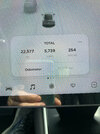Purpose of poll is to establish an equivalent to the ICE refueling level.
With ICE, at what tank level do you typically think about filling in gas?
Many people are comfortable driving ICE to E - 1/8 tank (0% - 12.5%), because gas is readily available and refueling is quick.
For Tesla, there are much less available charging options, and it's way slower to "refuel".
Unplanned long drives are no problem with ICE that can easily refuel to 100% at any time. With a slow charging Tesla, there is an incentive to keep charge levels higher.
Additionally, unlike ICE, Tesla features drop off: no sentry mode at 20%, performance decreases with lower charge levels.
Thus, I think the Tesla equivalent is 20% - 30%.
The other data point is that ICE is refueled to 100%, but Tesla is typically charged to 80% - 90%.
Finally the point:
Cars are listed for sale with an EPA range that is based on the fuel level going from 100% to 0%.
This can be a useful when comparing ICE to ICE, but not ICE to Tesla.
A better comparison is "practical EPA range", what range you would expect to get with typical refueling levels.
With ICE, practical EPA range = 87.5% - 100% of EPA range. (from 1/8 tank to E)
With Tesla, practical EPA range = 50% - 70% of EPA range. (from 80% -> 30% to 90% -> 20%)
Yes, this is mitigated for some who can charge daily at home or work, some people charge > 90%, drive lower than 20%, and EPA range is a somewhat phony number, etc, but...
The point is, practically speaking, the EPA range is a much phonier number for Tesla than it is for ICE.
Your mileage may vary.
--------
Tesla 3 SR+ = EPA range 269 miles = practical EPA range: 135-188 miles.
Tesla 3 Perf = EPA range 315 miles = practical EPA range: 158-221 miles
Tesla 3 LR = EPA range 353 miles = practical EPA range: 177-247 miles.
What is your practical EPA range?



